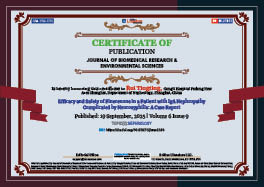Rui Tingting*, Sun Meimei, Xie Yijie and Chen Zhou
Volume6-Issue9
Dates: Received: 2025-09-01 | Accepted: 2025-09-16 | Published: 2025-09-19
Pages: 1309-1313
Abstract
IgA Nephropathy (IgAN) is one of the most common forms of glomerulonephritis, yet treatment options remain limited for patients who cannot tolerate immunosuppressive therapy. The management becomes particularly challenging in the context of active infection, such as syphilis, where immunosuppression poses significant risks. Finerenone, a novel non-steroidal Mineralocorticoid Receptor Antagonist (MRA), presents a promising non-immunosuppressive strategy to reduce proteinuria and slow the progression of Chronic Kidney Disease (CKD). We report the case of a 35-year-old woman with biopsy-proven IgAN (Oxford classification M0E0S0T0-C0) and persistent proteinuria, despite treatment with sacubitril-valsartan, dapagliflozin, hydroxychloroquine, and prednisone. Further immunosuppression was limited by complications including urinary tract infection and blurred vision. The patient was subsequently diagnosed with neurosyphilis based on neurological manifestations and cerebrospinal fluid findings. Given the contraindication to enhanced immunosuppression, finerenone was initiated as an add-on therapy. After titration to a daily dose of 20 mg, her proteinuria significantly decreased to below 100 mg/24h, without inducing hyperkalemia or reducing glomerular filtration rate. The treatment was well-tolerated, and no drug interactions were observed with concurrent penicillin therapy for syphilis. This case illustrates that finerenone may serve as an effective and safe adjunctive treatment for reducing proteinuria in IgAN, especially in complex clinical scenarios where standard immunosuppressive therapies are contraindicated or poorly tolerated-such as in the presence of an active concurrent infection.
FullText HTML
FullText PDF
DOI: 10.37871/jbres2186
Certificate of Publication

Copyright
© 2025 Tingting R, et al. Distributed under Creative Commons CC-BY 4.0
How to cite this article
Tingting R, Meimei S, Yijie X, Zhou C. Effi cacy and Safety of Finerenone in a Patient with IgA Nephropathy Complicated by Neurosyphilis: A Case Report. J Biomed Res Environ Sci. 2025 Sept 19; 6(9): 1309-1313. doi: 10.37871/jbres2186, Article ID: JBRES2186, Available at: https://www.jelsciences.com/articles/jbres2186.pdf
Subject area(s)
References
- Rodrigues JC, Haas M, Reich HN. IgA Nephropathy. Clin J Am Soc Nephrol. 2017 Apr 3;12(4):677-686. doi: 10.2215/CJN.07420716. Epub 2017 Feb 3. PMID: 28159829; PMCID: PMC5383386.
- Gleeson PJ, O'Shaughnessy MM, Barratt J. IgA nephropathy in adults-treatment standard. Nephrol Dial Transplant. 2023 Oct 31;38(11):2464-2473. doi: 10.1093/ndt/gfad146. PMID: 37418237; PMCID: PMC10794095.
- Rajasekaran A, Julian BA, Rizk DV. IgA Nephropathy: An Interesting Autoimmune Kidney Disease. Am J Med Sci. 2021 Feb;361(2):176-194. doi: 10.1016/j.amjms.2020.10.003. Epub 2020 Oct 8. PMID: 33309134; PMCID: PMC8577278.
- Cheung CK, Alexander S, Reich HN, Selvaskandan H, Zhang H, Barratt J. The pathogenesis of IgA nephropathy and implications for treatment. Nat Rev Nephrol. 2025 Jan;21(1):9-23. doi: 10.1038/s41581-024-00885-3. Epub 2024 Sep 4. PMID: 39232245; PMCID: PMC7616674.
- Suzuki H, Kiryluk K, Novak J, Moldoveanu Z, Herr AB, Renfrow MB, Wyatt RJ, Scolari F, Mestecky J, Gharavi AG, Julian BA. The pathophysiology of IgA nephropathy. J Am Soc Nephrol. 2011 Oct;22(10):1795-803. doi: 10.1681/ASN.2011050464. Epub 2011 Sep 23. PMID: 21949093; PMCID: PMC3892742.






























































